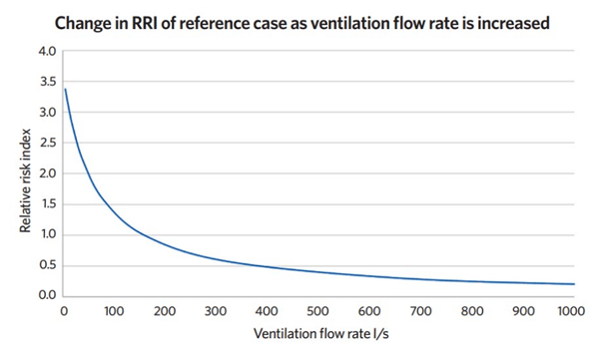As the scientific knowledge around the spread of the Coronavirus continues to develop, it is important to know which information is both correct and relevant for ventilation systems. The airborne potential of COVID-19 is high according to a recent report by the British Medical Journal which stated that microscopic respiratory droplets containing COVID-19 can hover in the air for minutes or even hours, and potentially drift many metres horizontally. Therefore, it is necessary for the air ventilation industry to be fully up to date with the latest theory around the capability for the airborne transmission of COVID-19.
 https://www.rehva.eu/fileadmin/user_upload/REHVA_COVID-19_guidance_document_V3_03082020.pdf
https://www.rehva.eu/fileadmin/user_upload/REHVA_COVID-19_guidance_document_V3_03082020.pdf
Building ventilation has always been an integral part of maintaining a healthy building environment, and in light of the Coronavirus it is an extremely valuable tool in the control of infection. Naturally, being able to ensure that a steady stream of outside air is flowing into the building whilst the stale air is continuously exhausted will help to prevent the spread of any respiratory virus such as COVID-19.
All employers are required by law to provide an adequate supply of fresh air in the workplace. A good system of ventilation can help to reduce the spread of Coronavirus, preferably through mechanical systems which can enhance the fresh air coming in.
The longer the exposure, the greater the risk
Coronaviruses were first identified as human pathogens in the 1960s. Much like a strong immune system, a strong ventilation system will be able to help in the fight to defeat the virus.
There are three dominant transmission routes for coronavirus which are:
- the combined droplet and airborne transmission in a 1-2 metre close contact zone. These droplets can be emitted when sneezing, coughing, singing, shouting, talking and breathing;
- long-range airborne (aerosol-based) transmission;
- surface contact through hand to hand contact, hand to surface.
Remaining socially distant from each other is obviously a huge part of stopping COVID-19 from spreading, but the risk of an aerosol cross-infection beyond 1.5m from an infected person can also be decreased with a well-designed ventilation system.
Ventilation is a very important way of diluting some of the airborne pathogens that carry the virus. There is strong evidence that demonstrates that occupants of a room are more at risk of catching an illness in a poorly ventilated room than in a well-ventilated room. This is because a poorly ventilated room means that the occupants of the room are exposed to a much higher concentration of airborne pathogens. Additionally, the risk for the room occupants will increase with a greater amount of time spent in such an environment.
 https://www.cibsejournal.com/technical/calculated/
https://www.cibsejournal.com/technical/calculated/
What do the experts say about the influence of ventilation on COVID-19?
Ventilation systems might have a complementary role in decreasing the transmission of COVID-19 in indoor spaces by increasing the rate of air change, decreasing the recirculation of air, and crucially by increasing the flow of outdoor air.
The Health and Safety Executive (HSE) has warned that if you are using a centralised ventilation system that removes and circulates air in to different rooms it is recommended that you turn off that recirculation and use a fresh air supply instead.
Some theory has been postulated that air conditioning systems are of high concern with regards to the spread of COVID-19. This has been suggested because air conditioning units generally only ventilate around 20% fresh air, therefore meaning that 80% of the air is being recirculated, potentially increasing the spread of COVID-19 from person to person.
Equally, HSE state that the risk of COVID-19 being transmitted by celling or desk fans are very low, again that is provided that a good supply of fresh air is in place.
The Federation of European Heating, Ventilation and Air Conditioning (REHVA) have published some theory on the role of ventilation systems in the spread of COVID-19 from the European Centre for Disease Prevention and Control (ECDC).
The ECDC promote the idea that COVID-19 can spread through ventilation systems in a building if the air is recirculated, for example in air conditioning units. The ECDC believe that the airflow produced by air-conditioning units may in fact facilitate the spread of droplets over a longer distance when indoors.
The ECDC recommends that building managers should ensure they maintain their systems in accordance with manufacturer's recommendations, particularly concerning the cleaning and changing of filters in there HVAC systems. According to the ECDC, if this action is taken, there is no benefit or need for additional maintenance cycles to combat COVID-19.
The most important thing for any ventilation system in combating the spread of COVID-19 is to ensure a well-maintained level of fresh air. Every space and building operation is unique and will require specific building assessment to help ensure that the ventilation is at a safe level. It is vitally important to fully understand your ventilation and how it works to be best prepared to combat the airborne transmission of the virus.
In my follow up blog, I will outline how Colt can help building managers to ensure they can provide the safest possible living space from the spread of Coronavirus.
In the meantime, find out more about Colt’s range of evaporative cooling systems
If your building is too hot or too cold, if your process gives off fume or moisture, if your product requires specific conditions during its manufacture or storage, or if noise is a concern, then we may be able to help you.
We can survey your building using a range of techniques and equipment to identify your problem. Once established, we can then recommend a solution based on proven design work.
Request a no obligation consultation with one of our technical experts
 Paul Langford is an Engineering Director with experience in product development, manufacturing and testing for HVAC, solar shading, louvre systems and smoke control applications.
Paul Langford is an Engineering Director with experience in product development, manufacturing and testing for HVAC, solar shading, louvre systems and smoke control applications.

